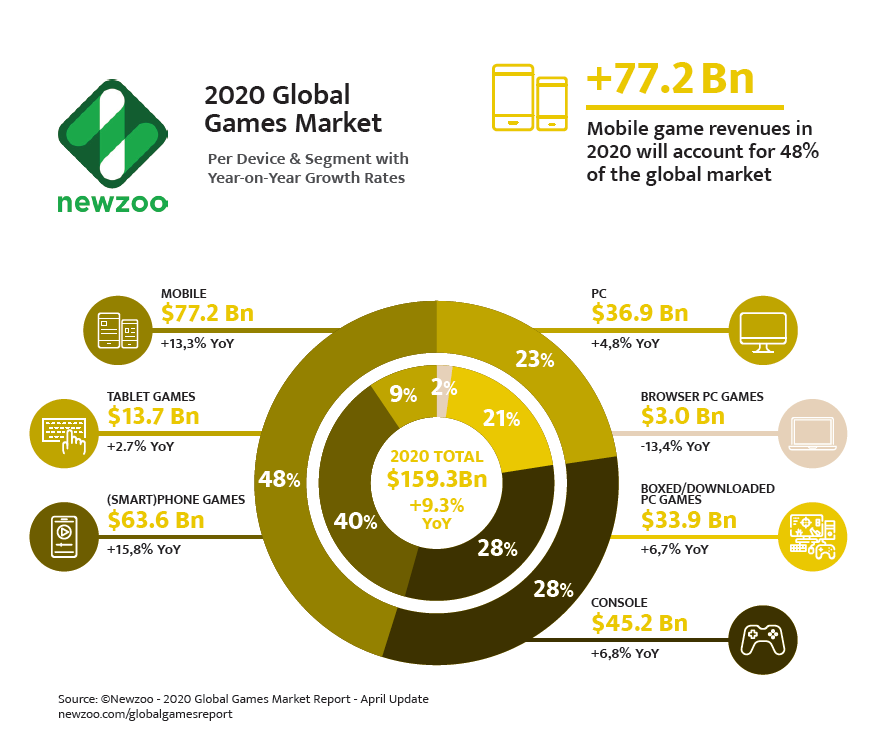Introduction to TriumphX (TRIX) part 2 — Decoding the gaming secondary market : limitations and solutions
Introduction
Newzoo estimated that the 2020’s global game market will generate revenues of $159.3 billion USD, which represents a healthy 9.3% year-on-year growth. While all game segments have an increase in engagement and revenues in 2020, mobile gaming experienced the biggest increase. In total, mobile games will generate revenues of $77.2 billion in 2020, growing +13.3% year on year, the fastest among all segments.

The vibrancy of the gaming market and Esport market has led to a third market that is rapidly growing; secondary market transactions for digital in-game items. The size of the market is estimated to have at least $50 billion USD of Gross Merchandise Value according to Juniper Research.
However secondary market transactions in its current form have the following limitations:
1) Lack of trust
Most online games lack a trust-less mechanism to trade in-game items between gamers. Most buyers have to trust that the seller sends over the in-game item after being paid in cash and vice versa. Third party custodial services are available, but they usually require a high transaction fee. This transaction fee could be as high as 10% of the whole transaction. This means that with an estimated industry size of $50 billion USD, up to $5 billion of value are being lost to fees.
2) Lack of security
In the current market, the most secure way a gamer could exchange secondary item is through a third-party custodial service. However, that itself comes with centralised risk. Gamers have to trust that the custodial services or trading bots are working as intended. Given the growth of the gaming industry and the worthiness of in-game items, the reward for successfully hacking a third party service is heightened. Using a third party means trusting that the security is up-to-date and bugs are fully patched. This is hard to monitor from an end user, and usually too late to be detected, until a breach has happened.
TriumphX solution for trust and security: TriumphX uses a smart contract to securely lock both the in-game item and TRIX tokens in the P2P transaction. The smart contract performs the transfer and release the item and tokens for both parties, only when the transfer requirements are fulfilled. Such blockchain service eliminates the need for trust among buyers and sellers and allows for seamless P2P transactions instantaneously.
3) Low liquidity
Trading of in-game items in the secondary markets is highly fragmented due to the large catalogue of available items across different games and products. This is exacerbated by the large number of third party providers which unnecessary segmented the market place and heighten price discovery costs.
4) Non-transparent information
Inventory details on in-game items is difficult to obtain. As of now, there is no transparent database on in-game item statistics. Gamers are kept in the dark on information, such as global quantity of items, or trading volume and new item issues. Without such information, market price tends to be highly volatile. Asymmetrical information in the in-game items marketplace leads to poor price discovery.
TriumphX solution for liquidity and transparency: TriumphX marketplace consolidates liquidity from the different marketplace into a single Non-fungible token (NFT) market. In addition, NFT liquidity providers are rewarded by an incentive mechanism to ensure sufficient trading liquidity in the market.
Similarly, through the combined synergy of a common marketplace, gamers will be able to monitor various in-game item statistics, (such as item inventory, total item existing, etc) available in the market. To improve market security, TriumphX will be using market information to identify bad actors and market manipulation.
5) Unsanctioned by most game providers
The biggest risk with third party secondary market providers lie in the issue where the original game creators could shut them down without much warning. Just recently in 2018, Valve issued a cease and desist order to OPSkins, one of the largest P2P custodial services at that time for conducting trades on the secondary trading of items. Valve has also deactivated all accounts related to the trades. Although no official statement or reason was issued for the shutdown, the market remains wary of using third party for in-game item trading.
TriumphX solution for game service providers: TriumphX gives games service providers like Valve the ability to benefit from secondary market trading. By collaborating with triumphX as a strategic partner, games service providers like Valve will be able to receive fees from all transaction done on TriumphX network. For game service providers and the gaming community, this creates a win-win solution as Value can reduce revenue slippage from secondary trading while gamers get a more complete gaming experience.
All in all, TriumphX aims to provide a decentralised exchange to conduct peer-to-peer (P2P) trading without the need for hefty fees and lose control of their digital in-game assets.
TriumphX was designed and built by gamers, for gamers.
**********************************
Follow our social media channels to keep up to date on our developments!
Twitter: https://twitter.com/TrixTriumphX
Telegram: https://t.me/TRIXcommunityEN
Website: http://trix.deeple.io/
Introduction to TriumphX (TRIX) — Decoding the gaming secondary market : limitations and solutions was originally published in TriumphX on Medium, where people are continuing the conversation by highlighting and responding to this story.


